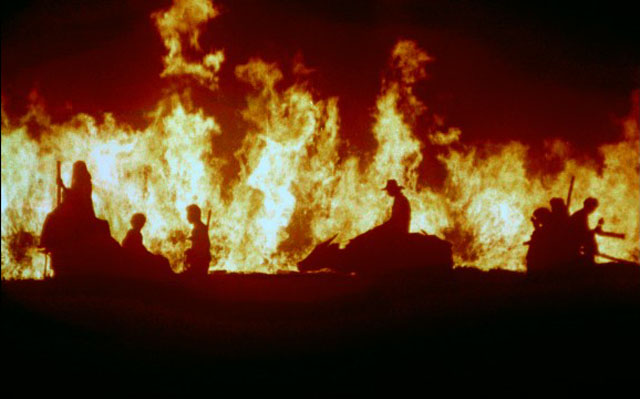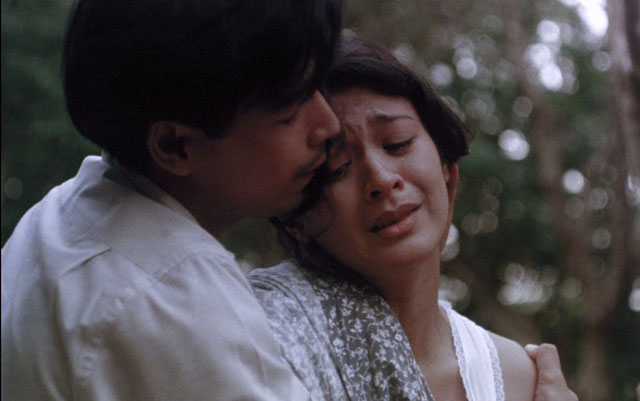ADVERTISEMENT
Filtered By: Lifestyle
Lifestyle
Movie Review: 'Oro, Plata, Mata' shines anew in HD
BY MIKHAIL LECAROS
The words “epic” and “saga” have lost some of their luster of late, co-opted by modern marketing teams to denote seemingly anything with a sequel.
Fortunately, unlike the overhyped, soulless soap opera fodder contemporary audiences have been forced to endure, the opening film of this year’s Cinema One Originals film festival, Peque Gallaga’s “Oro, Plata, Mata”, has been re-released to show everyone how it’s done.
Let me get this out of the way: “Oro” is not a perfect film. But as a testament to the creative abilities of a group of filmmakers at the peak of their powers, this is one local film that has more than earned its “epic” superlative.

The exodus scene, restored in HD, is as beautiful as it is iconic.
The object of over 1700 hours of frame-by-frame digital refurbishment by Central Digital Lab as part of the ABS-CBN Restoration Project, “Oro’s” HD resurrection brings to the big screen a vigor and vitality unknown to those who have only experienced the film through home video or the odd academic screening.
While not quite pristine, one is hard-pressed to complain; the film shows few of its 30 years, creating the effect of nothing less than a cinematic time machine. Looking for all the world like it was shot last week-–albeit with old film stock and lenses-–it takes little effort for the viewer to be transported to a place and time when Joel Torre and Cherie Gil were just starting out in their careers.
Colors long seeped into one another through copies of copies now pop off the screen, and details once-thought lost to the ravages of time and neglect assert themselves with renewed brilliance. Portions of the film that have benefited most from the restoration are the opening sequence (which formerly looked like it was shot through a Vaseline haze) and segments of high contrast, such as the families’ exodus (which rivals “Gone with the Wind’s” burning-of-Atlanta for sheer cinematic conflagration symbolism) and Manuel’s (an impossibly-young Joel Torre) inevitable trip into the jaws of Tartarus to rescue Trinidad (an even younger Cherie Gil).
The three-hour run time has always proven daunting for some, with some going as far as to suggest that the story told here would have been better served as a mini-series. But, having seen it now in the proper context-–far removed from the scratchy, nigh-incoherent VHS copies of yore-–one gets the impression that the pacing was entirely intentional.
Chronicling the experiences of two affluent families, the Ojedas and the Lorenzos, who live through the Japanese Occupation of the Philippines, Gallaga begins his tale in a manner immediately familiar to followers of Rizal, Coppola and turn-of-the-century upper societal classes: with a large family gathering. Lovingly shot and meticulously choreographed, the sequence is an exercise in classical storytelling, with the occasion’s ceremony, interactions and sub-interactions telling us everything we need to know about these characters and the rarefied world they inhabit, without the need for extraneous exposition.
From the hacienda’s social structure to the families’ penchant for gossip over endless rounds of mahjong, all the while attended to by a small army of servants, Gallaga infuses in his audience a familiarity–-not necessarily affinity-–for these characters. This he does to the point that, when everything comes undone, and their wealth and complacency are stripped away, it is just as jarring for them as it is to the viewer.
We never actually see the enemy–-save for one wayward soldier late in the film-–but their presence permeates every moment. As the months go by and the families embark, unknowingly, on their descent into the wilderness of madness, we gain context into the country’s situation through second-hand information, gossip (mostly from Lorli Villanueva’s Viring) and outright speculation.

Joel Torre and Sandy Andolong play Oro's doomed lovers
Taking the lead in a cast of future superstars is Manny Ojeda as Don Claudio Ojeda, who brings a preternaturally old-school dignity and calm to his scenes. Even as misfortune after misfortune befalls the clan, and everyone around him spirals into insanity, you never doubt for a second that he remains the patriarch. It is heartbreaking when he is finally broken into shell-shocked, submissive silence.
“Oro, Plata Mata” was designed as a commentary on the follies of excess and consumption at a time when such commentary may not have been the wisest or the safest action to make. That the film was made at all with the degree of artistic fealty on display is tribute to the filmmakers’ tenacity--or is it insanity?
Before last Wednesday’s premiere screening, Peque Gallaga declared “Oro” as the work of fools who didn’t know any better. Had they known what they were in for when they started, they probably wouldn’t have bothered at all, let alone see it through.
Thus, not knowing any better, the creators of “Oro” proved that, as far as many a follower of Philippine Cinema will attest to, they damn well were the right fools at the right time. Today, with digital technology replacing traditional techniques and a new generation of fools at the fore, this reviewer will remain ever grateful that this saga got an even break.
We should all be so foolish. --KDM, GMA News
A lifelong fan of cinema and literature kept ambulatory by an ungodly mix of sugar, caffeine and adrenaline, Mikhail Lecaros is a professional magazine editor and freelance writer who's decided that he wants to be Hunter S. Thompson if and when he is forced to grow up. The views expressed in this article are solely his own.
More Videos
Most Popular




